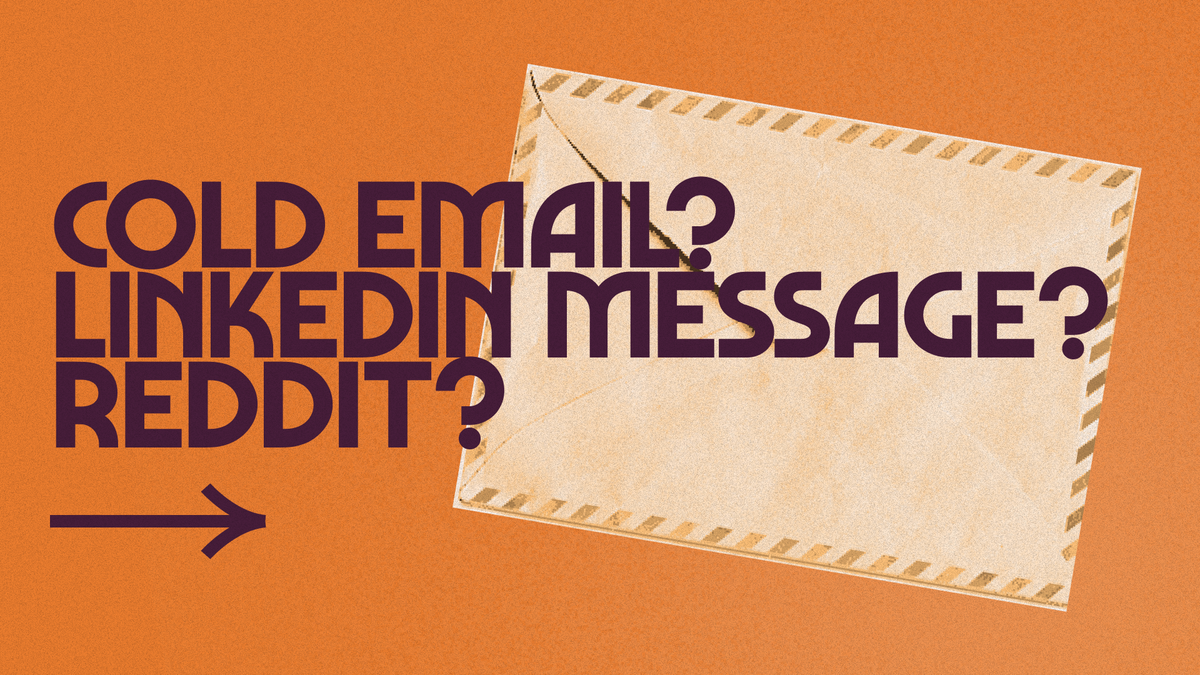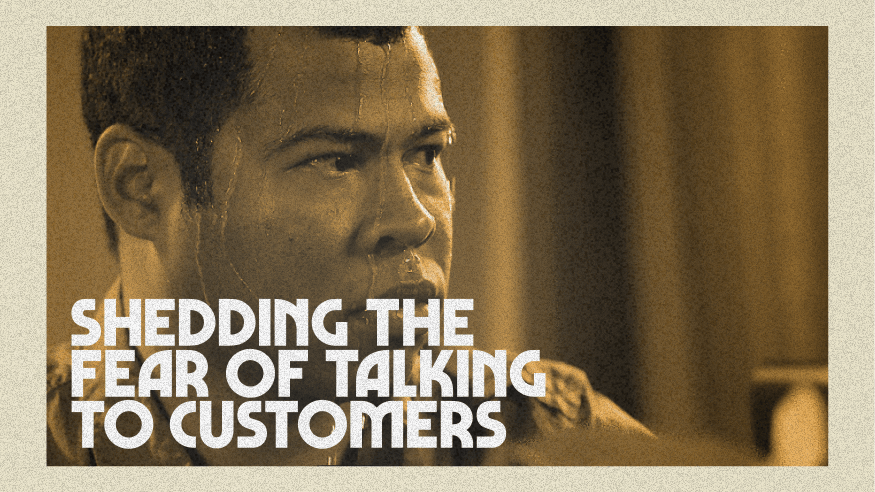How do you recruit B2B research prospects when you don't know them beforehand?
Learn how you can get in touch with your future customers when you don't know them

I asked the Indie Hackers community "What was stopping them from talking to their customers?" and I got this response from Pragyan Tripathi:
"Hi Shavin, my principal challenge is making the first contact with prospective customers if I do not know them beforehand. I am not sure if cold emails work well for a niche product, and I have tried reaching out in Linkedin to a few people without success. My objective right now is just to understand if I am solving a pain point, but even getting that feedback seems pretty hard. Any ideas/suggestions from your experience?"
I thought it would be to expand upon some of the ideas that I shared with Pragyan.
It can be difficult to find prospective customers to speak with in order to figure out whether the problem you're solving is a painful one that B2B audiences face.
- Do you send cold emails?
- What about LinkedIn messenger?
- What about Reddit?
After attempting a few of these channels, it can begin to feel like an uphill battle to break free from your own echo-chamber of thoughts and hear from those who may be experiencing the problem.
It's even more difficult when these audiences are wary of being sold to or have their time wasted. You know you're not going to sell them something or waste their time, but you also need to talk to them to see if the problem is as serious as you think it is.
Given what you've tried so far, you may begin to feel like it isn't such a big deal to them. However, you have an itch to figure it out and it's time to scratch it. So how do you go about recruiting in such a way that you have a good chance of actually speaking with someone?
Ask close contacts you already know to make an introduction or a connection
When you're starting out it's easy to disregard your current network to go after people you don't know directly but there's a hotbed of opportunity within the circles that you associate with. So, leverage your network who have an association to the prospect that you want to talk to. Here's how:
- List out all the people you know who work in the industry/vertical/category that you plan on competing in.
- Then create a template message with a sincere tone explaining your circumstance with your new business venture and tell them that you're looking to talk to people in the specific role who faces the problem. It's even better if you know the person you want to talk to so that it makes it easier for them.
- When you're sending it to them make sure you edit your message so that it maintains relevancy to the person receiving it.
Why will this work? Because you already have a relationship with the person you're speaking with, they'll most likely be eager to assist you and be a part of your entrepreneurial journey by introducing you to someone they know.
Give something small and valuable BEFORE asking for a call in return
Nobody cares what you can do.
— jckbtchr (@jackbutcher) July 23, 2020
Everybody cares what you can do for them.
This is one of my favorite methods, with the caveat that finding out what your audience cares about takes time and some internet research.
When you have a good understanding of the pain you're solving, offer something of value upfront before asking for a call.
The value you deliver could vary. The way I choose to think about it is you're either helping them make their lives more awesome or less awful through what you know.
Here's an example of Alan from Growth Gorilla sending a cold email to Irina head of Product Marketing at Hunter with a 5 minute video tip to increase traffic to their content.
This one is a great example. Instead of asking to jump on a call right away, @AlanGGorilla offers to send a 5-min video with tips on how to increase traffic to our content. pic.twitter.com/wUMQWkxrxI
— Irina Maltseva (@irinamaltseva) November 4, 2021
I've been following Irina for awhile I know that she writes blog posts for Hunter (a tool that helps you connect with anyone). Someone who may want to collaborate with her could've used Alan's approach because he has expertise in the domain that Irina is putting effort into.
Yes, it sounds like a sales tactic, but it works for customer interview recruiting as well! And it'll work better because you're not selling anything. You're there to listen to their problems from their point of view. It also works as a result of a few cognitive biases that we have. Namely, reciprocity, labour illusion, and temptation building.
Read reviews on websites of competitor products
No matter how revolutionary your idea might be, it has to be adopted by a market. And the market has to be doing something in order to make progress. This is one of the core principles of jobs theory, there are no new jobs just different solutions.
You can use websites like Capterra or G2 and browse through the reviews to find people who are describing the pain that you're aware of with their current tool of choice.
Here's how to use this approach:
- Create a spreadsheet with a list of names with a link to the original post and try to find their email (use Hunter for this) or their social media. Then reach out to them and relate to their post on the review site.
- Couple this approach with the value driven approach for better results!
Join & listen in on niche communities
For a marketplace to exist there has to be demand in the form of pain or struggles, and chances are that people who face problems in your vertical are actively gathering in online communities like Reddit or Facebook groups to discuss their problems and seek advice from experts.
List out all the communities where your prospects might be hanging out in and then you can actively search for keywords that they use to describe the pain that you're solving for. Or use a social listening tool like Gummy Search to notify you when someone posts something new.
The Hive Index, is a great place to start your search for communities.
Pro tip: in anonymous communities like Reddit it would help you to get responses if you had an incentive to offer. An amazon gift card will do.
Ask past/current interview participants if they know anyone you could speak to
When my participant pipeline looked thin in the past, I made sure to ask "do you know anyone else I could talk to?" at the end of an interview. Most of the time, participants had other people I could contact.
If they show some evidence that they know someone, you can reach out to them within a few days requesting them to make a connection.
That's 5 ways you can fill up your pipeline with interview participants!
Now, here's what you need to do to hit the ground running.
- Start by making a commitment strategy with a goal in mind. I suggest getting at least 10 confirmed participant bookings within a span of 2 weeks.
- Choose one of the approaches that you feel like is a low effort but will have a high impact on increasing your odds of getting a prospect to talk to you. Maybe you have friends who can put you in touch with someone you want to talk to. Maybe you already have a bunch of resources or knowledge that you can offer a prospect before making an ask. Choose whichever is easiest to get started!
- Craft your initial message, depending on the approach you want to take to recruit someone. Need help with it? DM me on Twitter.
- Send the message!
When you're in a discovery phase of your business and don't actually have something to "sell" or show, this can feel like busy work but it isn't. Doing this upfront work can save you tons of time & money down the line if what you imagined isn't matching up to reality. But then you can iterate, that's the point of learning!
From experience, the only barrier that will get in your way is your motivation to learn & be curious but now you don't have to rely on it. Just use an approach from above!
If you liked this, you might enjoy these out too!
- How to build a bare minimum feature - An article on asking the right questions to shape up a feature.
- Principles of a JTBD interview - Need guardrails to keep your interview in check? These principles will help you.
- Do's and Dont's around getting people to open up - This is from Michele Hansen's Book Deploy Empathy.
References
- Chapter 5 of Deploy Empathy also has a great guide on recruiting users from different channels, including scripts. Be sure to check it out as well!
- The Psychology of Design - 106 Cognitive Biases & Principles That Affect Your UX





